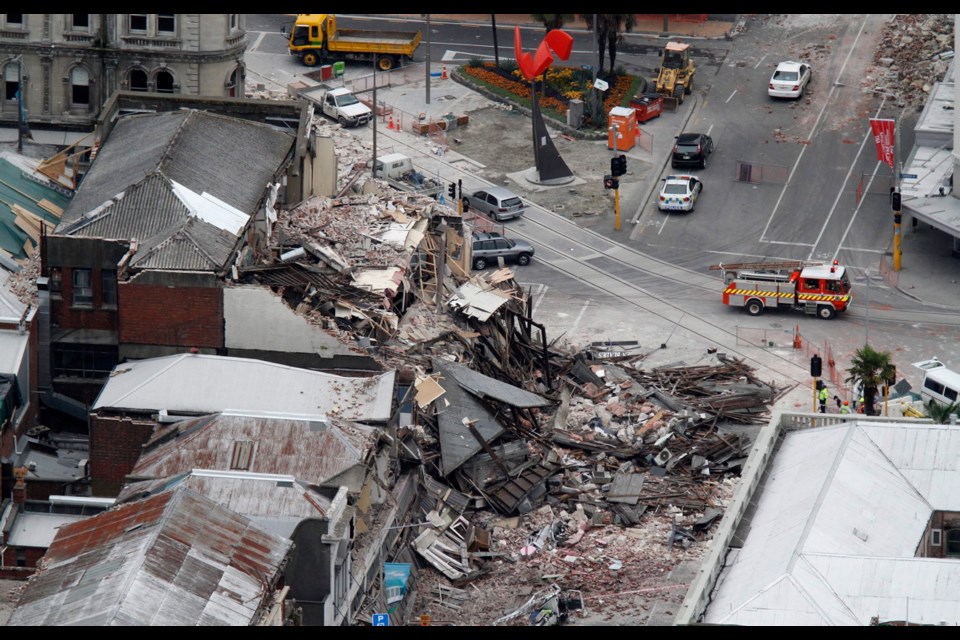CHRISTCHURCH, New Zealand — Imagine a child’s jigsaw puzzle, about 20 large pieces. Take five and put them back in the box. Put the puzzle together. Look at it. This is Christchurch from the air today, seven years after the earthquake.
Let me recap from down under, where Pauline and I are travelling.
At 4:35 a.m., Sept. 4, 2010, a 7.1-magnitude earthquake, with the epicentre 40 kilometres away and 12 kilometres below the surface, rattled Christchurch. Limited damage, but infrastructure cracked and weakened.
On Feb. 21, 2011, during lunch hour, a 6.3-level quake occurred, but only eight km away, and importantly, only three km deep. Only 10 seconds, followed by a roller-coaster ride of relief and terror as within 10 minutes there were 10 aftershocks of magnitude 4.0 or more.
There were 185 killed and 164 seriously injured. One six-storey building — housing the local television headquarters, a medical clinic and an English-language school — pancaked, with 115 killed.
About 100,000 houses were damaged, and 10,000 demolished. The central business district closed for two years because 1,240 buildings — one in three — collapsed or were damaged beyond repair. The city’s symbol, the Anglican Cathedral, was uninhabitable. Miles of sewer and water systems were destroyed.
Liquefaction describes the process during an earthquake where sand, silt and water are combined under incredible pressure. The water/soil/sand mixture boils, volcanoes through cracks to the surface, and begins to move like ocean waves, tilting, sinking and tossing buildings, roads and pipes like flotsam.
The Avon River meanders through the broad plain where Christchurch was built, mainly swampland and river silt. The whole downtown and suburbs along the fault line experienced liquefaction. The damage discriminates — one neighbour loses everything, the other across the road, nothing.
The financial costs are astronomical. To date, about $32 billion has been spent out of an estimated $45 billion to $50 billion, with reconstruction to be completed by 2026. Expenditures have been split between private insurance ($20 billion) and public monies ($12 billion). A government corporation pays benefits to everyone with private fire insurance, but it is capped at $100,000 for home replacement.
Instead of swampland, the area around Victoria’s harbour is built on pilings driven into the ocean. The legislative precinct, the Royal B.C. Museum, the Empress and the Inner Harbour downtown core would be gone. The Saanich Peninsula, if caught along a fault line, would have liquefaction destruction.
Too dramatic? Come and see Christchurch.
Could Victoria handle this type of catastrophe?
First, this type of disaster planning, both reaction and reconstruction, does not have the top-of-mind priority compared to our collective perception of global warming issues, or the immediacy of the Kinder Morgan project.
Global warming issues come along gradually, like death by a thousand cuts. Earthquakes are nature’s randomly selected future date for the collective guillotine.
Second, the performance of local government in minding taxpayer monies has not been demonstrated, and any discussion of public monies for capital projects has been terribly jaded by the mishandling of the Blue Bridge replacement and sewer-project implementation.
Third, there is no confidence that under the current regional-government system, a disaster that will discriminate between municipalities will generate a timely, effective and unified response.
Remember Esquimalt versus the NIMBY-other-municipalities over the sewer project.
Immediate disaster-preparedness planning for protection of citizens when an earthquake or tsunami strikes is already well handled. But, as Christchurch shows, that is only half the issue.
The other side of the coin is how we plan for the capital-replacement financial issues.
Greater Victoria is the same size as Christchurch, and imagine $50 billion required capital for reconstruction. This requires public expenditures of about $20 billion. How would we manage that?
New Zealand had proactively built local capacity to deal with an earthquake’s ramifications through amalgamation. But this would involve the dreaded ‘A’ word, and my grandchildren’s grandchildren will be gone before Greater Victoria municipalities agree. And, since there is only downside politics for a provincial government to act, it might never happen.
Therefore, if Victoria can’t amalgamate, and the province will not act, where do we go?
The system cries out for new political ideas. Amalgamation is a dead horse. Regional government in Greater Victoria has financial accountability and co-ordination problems among 13 municipalities. We are vulnerable.
One idea is found in London, England. It recognizes local governments are essential for locally delivered services — leave them alone. Instead, they elect a regional government and mayor to be responsible and accountable for a narrow list of responsibilities with the concomitant tax authority.
Get rid of the current regional system. After all, below the Malahat, our earthquake is when, not if.
Bob Plecas of Victoria retired after a career as a senior civil servant with the provincial government, where he was deputy minister for 25 ministers in 10 different portfolios.



